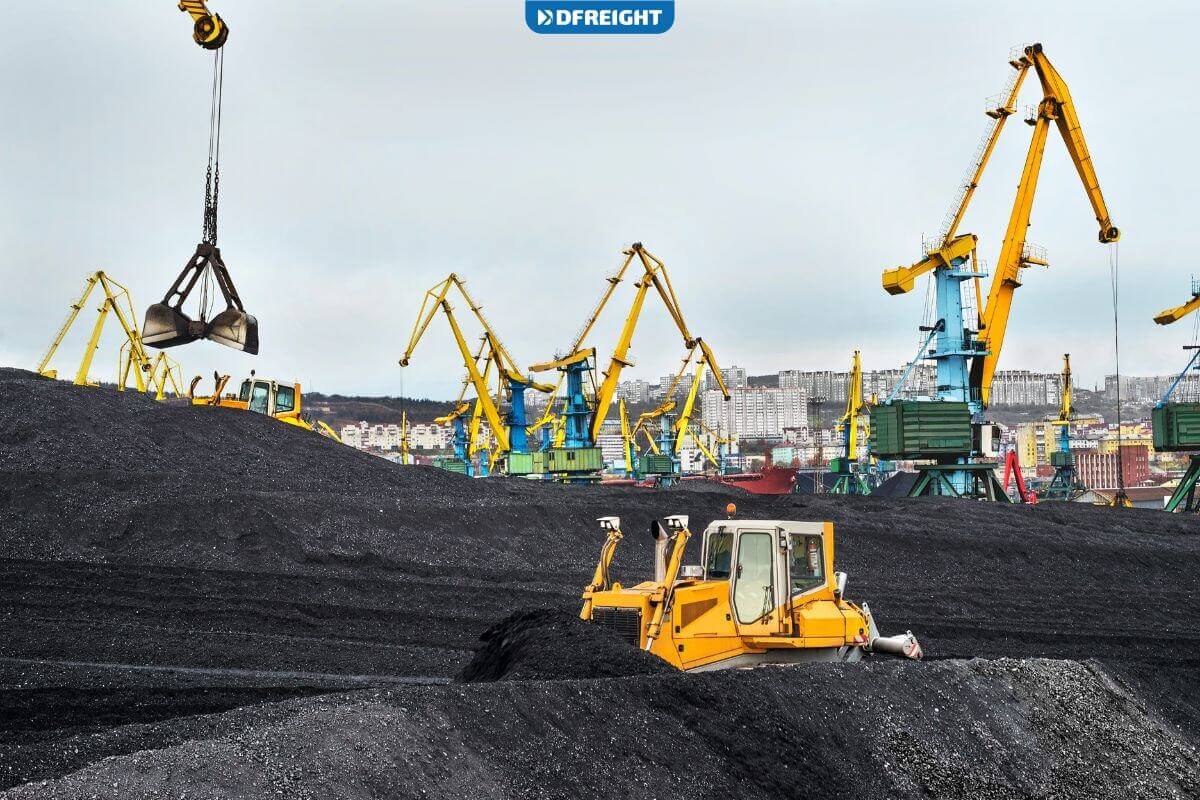Welcome to an exploration of the intricate world of shipping metals and minerals, where raw materials traverse oceans and continents to fuel industries and innovation. This guide delves into the significance, challenges, and solutions that shape this vital aspect of global trade. Join us on this journey as we unravel the complexities of transporting the elements that build our modern world.
When it comes to shipping metals and minerals, a reliable freight forwarder can make all the difference. At DFreight, we specialize in efficient, secure, and compliant cargo solutions tailored to your needs. From bulk shipping to containerized transport, we’ve got you covered every step of the way. Let us navigate the complexities while you focus on your core business. Reach out today to experience seamless shipping with DFreight!
Table of Contents
Understanding the Importance of Shipping Metals and Minerals
Metals and minerals are foundational in modern society, serving as essential raw materials for industries ranging from construction and manufacturing to technology and energy production. The global demand for these resources continues to rise, necessitating a robust and efficient shipping infrastructure to facilitate their movement across vast distances.
The transportation of metals and minerals is a critical component of the global supply chain, linking resource-rich regions with centers of production and consumption around the world. Metals like iron, aluminum, and copper are the building blocks of infrastructure, machinery, and electronics, while minerals like coal and rare earth elements are vital for energy production and advanced technologies. The seamless movement of these materials ensures a continuous flow of resources that underpin economic growth and technological advancement.
Challenges and Considerations in the Shipping Industry
While the importance of shipping metals and minerals is evident, the journey from extraction to consumption is fraught with challenges and considerations. Several factors contribute to the complexity of this process:
- Regulatory Compliance and Documentation: The international nature of shipping requires adherence to a myriad of regulations, ranging from safety protocols to customs requirements. Accurate documentation and compliance are essential to avoid delays, fines, and legal complications.
- Packaging and Handling Requirements: Different metals and minerals have unique characteristics that necessitate specific packaging and handling techniques. Some materials are corrosive, flammable, or sensitive to moisture and temperature changes, requiring meticulous packaging to prevent damage or contamination during transit.
- Environmental Concerns: The extraction, processing, and shipping of metals and minerals can have environmental impacts, including habitat destruction, water pollution, and carbon emissions. Balancing economic needs with sustainable practices is an ongoing challenge.
- Supply Chain Disruptions: Geopolitical tensions, natural disasters, labor strikes, and other unexpected events can disrupt supply chains, leading to delays and shortages in the availability of metals and minerals.
- Logistical Complexity: Shipping metals and minerals often involves multiple modes of transportation, border crossings, and intermediary storage points. Coordinating these processes requires efficient logistics management.
- Safety and Security: Ensuring the safety of workers, the integrity of cargo, and protection against theft or piracy is a paramount concern in shipping valuable and sometimes hazardous materials.
By understanding the intricacies of shipping metals and minerals, stakeholders in this industry can navigate the complexities more effectively and contribute to a seamless global supply chain.
Understanding Metals and Minerals
Delving into the world of shipping metals and minerals requires a foundational understanding of the materials themselves. In this section, we explore the diverse array of metals and minerals shipped globally and an overview of market dynamics and demand that drive this essential aspect of international trade.
Types of Metals and Minerals Shipped
Metals and minerals span a wide spectrum, each contributing to distinct industries and applications. From industrial giants to specialized components, the following are some of the key types frequently shipped:
- Base Metals: Including copper, zinc, and aluminum, these form the backbone of industrial processes, from construction and manufacturing to electrical infrastructure.
- Precious Metals: Gold, silver, platinum, and palladium hold monetary and industrial value, often playing roles in jewelry, electronics, and investments.
- Iron Ore: The essential ingredient for steel production, iron ore is transported in vast quantities to feed the global demand for infrastructure and manufacturing.
- Coal and Minerals: Vital for energy production and industrial processes, coal and minerals like limestone, phosphate, and sulfur are transported to power plants and production sites.
- Rare Earth Elements: These elements are crucial for advanced technologies like electronics and renewable energy systems, driving demand for efficient shipping solutions.

Market Overview and Demand
Understanding the economic dynamics and demand patterns is pivotal in comprehending the shipping landscape of metals and minerals:
- Global Supply and Demand: Economic growth and industrial activity shifts impact demand for metals and minerals. Developing economies, in particular, drive the demand for raw materials.
- Infrastructure Development: As nations invest in infrastructure projects, demand for construction materials like steel and cement increases, influencing shipping patterns.
- Technological Advancements: The rise of electric vehicles, renewable energy, and high-tech industries elevates the demand for specific metals like lithium, cobalt, and rare earth elements.
- Commodity Markets: The fluctuation of metal prices in commodity markets influences production and shipping decisions, as higher prices often drive increased mining and export activities.
- Environmental Considerations: Growing awareness of sustainability and responsible sourcing influences the demand for metals and minerals extracted and shipped with minimal environmental impact.
In essence, comprehending the nuances of the types of metals and minerals and their demand dynamics sets the stage for effective shipping strategies. This understanding guides logistics planning, risk assessment, and the development of solutions that cater to the unique requirements of each material.
Preparing for Shipping
Before metals and minerals embark on their journey across the vast expanse of the global supply chain, meticulous preparation is essential. This section delves into two crucial aspects of this preparation: regulatory compliance and documentation and packaging and handling requirements.
Regulatory Compliance and Documentation
Navigating the labyrinth of international shipping regulations and customs procedures is a fundamental prerequisite for successful metal and mineral transportation. Failure to adhere to these regulations can result in delays, fines, and even the confiscation of cargo. Key considerations in this realm include:
- Customs Documentation: Accurate and complete documentation is essential. This includes bills of lading, certificates of origin, commercial invoices, packing lists, and any required permits or licenses. Non-compliance can lead to customs clearance delays or cargo refusal.
- Hazardous Materials Regulations: Many metals and minerals fall under hazardous materials categories due to their properties. Proper classification, packaging, labeling, and documentation are vital to ensure the safety of transport workers, the environment, and other cargo.
- International Trade Agreements: Understanding trade agreements and tariffs between countries is critical. Utilizing preferential trade agreements can lead to reduced costs and smoother customs processes.
- Sanctions and Embargoes: Compliance with sanctions imposed by international bodies or individual countries is essential to avoid legal complications and reputational damage.
- Insurance Requirements: Adequate cargo insurance is a safety net against unforeseen events during shipping. Different types of coverage are available to address various risks.
Packaging and Handling Requirements
The safe transit of metals and minerals hinges on appropriate packaging and handling practices. These materials often vary significantly in terms of weight, fragility, and chemical properties, necessitating careful consideration of packaging methods and transportation conditions:
- Corrosion Prevention: Metals prone to corrosion must be protected from exposure to moisture and air. Properly sealed packaging and the use of desiccants can help mitigate the risk.
- Fragile Minerals: Delicate minerals require shock-absorbent packaging to prevent breakage during transit. Cushioning materials like foam, bubble wrap, or padding are essential.
- Temperature Control: Some minerals are sensitive to temperature fluctuations. Insulated packaging and temperature-monitoring systems are crucial for maintaining product integrity.
- Bulk Cargo: Bulk shipping is common for minerals like coal and ores. Proper loading, securing, and stowage techniques are necessary to prevent shifting during transportation.
- Labeling and Marking: Clear labeling indicating contents, handling instructions, and hazard warnings aid in proper handling and reduce mishandling risk.
- Weight Distribution: Proper weight distribution within shipping containers is critical to maintaining stability and preventing container and cargo damage.
By meticulously adhering to regulatory standards, ensuring accurate documentation, and employing appropriate packaging and handling techniques, shippers can minimize risks and enhance the efficiency of their operations. In the next sections, we’ll explore the various modes of transportation available for shipping metals and minerals, each with its unique requirements and considerations.
Modes of Transportation
Selecting the right mode of transportation is a pivotal decision when it comes to shipping metals and minerals. The choice depends on factors such as the type of cargo, distance, urgency, and cost considerations. This section delves into the three primary modes of transportation: ocean freight, air freight, and land transportation.
Ocean Freight: Bulk Carriers and Container Ships
Ocean freight remains a cornerstone of global trade, particularly for shipping bulk quantities of metals and minerals. Two prevalent methods of ocean freight are bulk carriers and container ships:
- Bulk Carriers: These specialized vessels are designed to carry large quantities of unpackaged materials, such as ores, coal, and grains. Bulk carriers are classified into different types, including dry bulk carriers for solid materials and liquid bulk carriers for liquids like petroleum. These ships are efficient for transporting massive quantities at lower costs, but they lack the versatility of containerization.
- Container Ships: Containerization has revolutionized the shipping industry. Metals and minerals can be packed into standard containers, ensuring ease of handling, efficient loading and unloading, and protection from external elements. This method suits smaller quantities, high-value items, and materials requiring specialized handling.
Air Freight: Considerations and Benefits
Air freight offers unparalleled speed and efficiency, making it ideal for transporting time-sensitive or high-value metals and minerals. While the higher cost compared to ocean freight can be a deterrent, air shipping presents several advantages:
- Speed: Air transportation significantly reduces transit times, making it suitable for urgent deliveries or items with a short shelf life.
- Global Reach: Airports cover extensive networks, allowing metals and minerals to be transported to remote locations that may be inaccessible by other means.
- Reduced Risk of Damage: Air shipments generally experience fewer handling points, decreasing the likelihood of damage.
- Temperature Control: Specialized air cargo containers can offer temperature-controlled environments vital for sensitive minerals.
- Security: Airports have stringent security measures, reducing the risk of theft and damage during transit.
Land Transportation: Trucks and Railways
Land transportation plays a pivotal role in bridging the gap between seaports, airports, and the final destination. Trucks and railways are the primary means of land transport for metals and minerals:
- Trucks: Trucks provide flexibility in reaching locations inaccessible by larger vehicles. They are suitable for smaller quantities and shorter distances. Careful route planning, proper securing of cargo, and adherence to road regulations are vital for successful trucking.
- Railways: Rail transport efficiently moves bulk quantities of metals and minerals over long distances. Railways are particularly advantageous when connecting production sites to ports or inland distribution centers. Proper loading, securing, and coordination are critical for safe rail transportation.
Understanding the nuances of each mode of transportation allows shippers to make informed decisions that optimize their supply chains. The next sections delve into the intricacies of freight containerization, specialized handling and safety measures, and the logistics and supply chain management aspects crucial for successful shipping of metals and minerals.
Freight Containerization
Containerization has reshaped the way metals and minerals are shipped, offering a standardized and efficient approach to cargo handling and transportation. This section explores the world of freight containerization, including the various types of containers used for metals and minerals and the importance of proper loading and securing techniques.
Types of Containers for Metals and Minerals
Containers come in various sizes and configurations to accommodate different types of cargo. When shipping metals and minerals, selecting the appropriate container type is crucial:
- Dry Containers: These are the most common containers used for general cargo. They are suitable for shipping non-perishable metals and minerals. Standard sizes include 20-foot and 40-foot containers.
- Open Top Containers: Ideal for oversized items or requiring top-loading, such as machinery or large metal pieces. The top can be removed, allowing for easy loading and unloading.
- Flat Rack Containers: These containers have collapsible sides, making them suitable for heavy or bulky cargo. They are often used for shipping large machinery, vehicles, or metal structures.
- Refrigerated Containers: For minerals and metals requiring temperature control, such as perishable minerals or those sensitive to temperature changes.
- Specialized Containers: In some cases, specialized containers are designed to meet specific cargo requirements, such as those that offer ventilation or humidity control.
Loading and Securing Cargo
Proper loading and securing of cargo within containers are vital to prevent damage during transit, ensure safety, and maintain the integrity of the supply chain:
- Stowage Plan: A well-thought-out stowage plan ensures that cargo is loaded in a balanced manner, preventing shifting during transportation. Heavier items are usually placed at the bottom, with lighter items on top.
- Securing Equipment: Using appropriate securing equipment such as lashings, chains, and straps prevents cargo from moving within the container. This is especially crucial for preventing damage during rough sea voyages.
- Blocking and Bracing: Inserting blocks or braces between cargo items and container walls helps distribute the forces generated during transportation and prevents damage from impact.
- Weight Distribution: Evenly distributing the weight within the container helps maintain stability during loading, unloading, and transportation. Uneven weight distribution can lead to tipping or structural damage.
- Cargo Integrity: Proper packaging and cushioning within the container protect the cargo from impact and vibrations. This is particularly important for delicate minerals and metals.
- Container Sealing: Securing the container with proper seals and locks helps prevent tampering and theft during transit.
Effective loading and securing not only protect the cargo but also contribute to overall safety and operational efficiency. By following best practices and adhering to industry standards, shippers can ensure that metals and minerals reach their destination in optimal condition.
Choosing the Right Shipping Partner
Selecting the right shipping partner is a crucial decision that significantly impacts the success of shipping metals and minerals. A reliable and experienced freight forwarder can streamline the shipping process, ensure compliance with regulations, and provide cost-effective solutions.
Factors to Consider in Selecting a Freight Forwarder
- Experience and Expertise: Look for freight forwarders with a proven track record in shipping metals and minerals. Experience in handling these materials equips them with the knowledge to navigate challenges effectively.
- Global Network: A well-established network of agents and partners in key locations ensures seamless operations and the ability to overcome logistical hurdles.
- Regulatory Knowledge: An understanding of international shipping regulations, customs procedures, and hazardous materials handling is essential for a successful partnership.
- Handling Capabilities: Verify that the freight forwarder can accommodate your cargo’s unique handling requirements, such as hazardous materials or temperature-sensitive shipments.
- Insurance Coverage: Adequate cargo insurance coverage minimizes financial risks in case of accidents, damages, or losses during transit.
- References and Reviews: Seek references or read reviews from other clients who have shipped similar cargo. This provides insight into the freight forwarder’s reliability and service quality.
- Communication and Customer Service: Effective and responsive customer service addresses issues, provides updates, and ensures a smooth shipping experience.
In the ever-evolving landscape of global trade, selecting the right shipping partner is a pivotal step in ensuring the seamless movement of metals and minerals. By carefully evaluating factors such as experience, services, and costs, you can forge a partnership that maximizes efficiency and minimizes risks.
Ready to Ship Smarter? Let’s Power Your Cargo with Expert Solutions!
Navigating the intricate world of shipping metals and minerals unveils complexity, innovation, and interconnectedness. From regulatory compliance to specialized handling, this guide has illuminated diverse industry challenges.
In today’s evolving global economy, transformative solutions like DFreight emerge, offering real-time tracking and efficiency that reshape logistics. Armed with insights, professionals and newcomers are poised to navigate triumphs and tribulations of transporting these resources.
Metals and minerals underpin our world, and mastering their transportation contributes to progress. The road ahead involves knowledge, collaboration, and innovation—ensuring seamless movement propels economies and shapes a future of strength and possibility.
Why are shipping metals and minerals important?
Shipping these resources connects global industries, fueling construction, technology, and energy sectors vital for economic growth.
What challenges are faced in shipping metals and minerals?
Handling hazardous materials, complying with regulations, and managing environmental impact are common challenges.
What are critical minerals?
Critical minerals, like rare earth elements, are crucial for advanced technologies, defense, and clean energy applications.
What role do regulations play in shipping?
Regulations ensure safety, security, and environmental responsibility, guiding proper packaging, labeling, and transport of materials.
Why is a reliable freight forwarder essential in this industry?
A professional freight forwarder streamlines logistics, ensuring efficient, compliant, and secure movement of metals and minerals.














